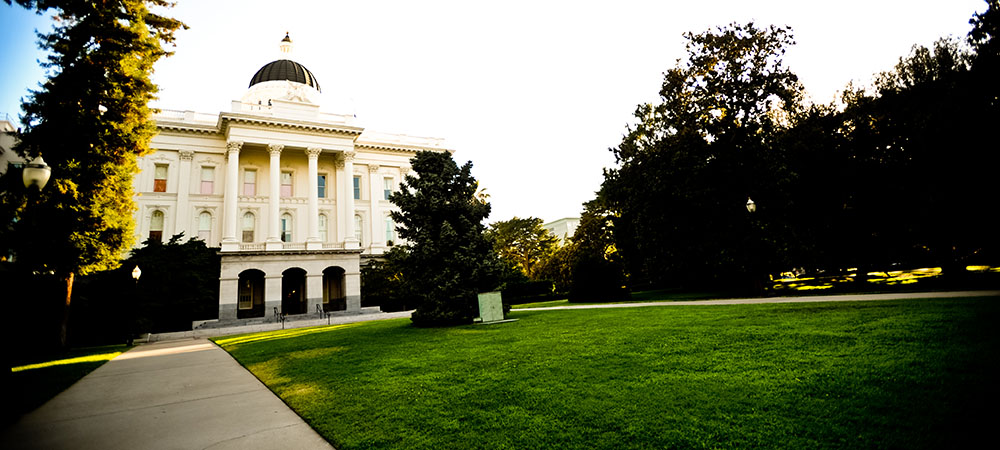
(Photo: Violeta Vaqueiro/CA FWD)
Update 9/23 – Governor Gavin Newsom signed the wildfire and forest resilience package totaling $1.5 billion and the $600 million Community Economic Resilience Fund bill.
California legislators approved key measures in the final days of the 2021 session that hold promise for a healthier, more resilient, and more equitable state. Pending approval by Governor Newsom, the bills would proactively address some of California’s greatest needs, including regional economic resiliency, forest health and wildfire prevention, and broadband access for those lacking adequate service.
“Taken individually, these are significant actions standing on their own,” said Micah Weinberg, CEO of California Forward (CA FWD). “Together, they mark a historic collection of investments that are aimed squarely at some of the most complex challenges facing our state.”
Passage of these legislative milestones required regional collaboration, perseverance, and fidelity to the triple-bottom line values of social equity, environmental sustainability, and economic growth. Here is a look at the accomplishments:
Community Economic Resilience Fund Program
On September 9, the Legislature passed SB 162, which established the $600 million Community Economic Resilience Fund (CERF) Program. The goal of the legislation is to support regions in planning and implementing regional economic strategies to strengthen their economies and develop more sustainable and equitable economies in the future.
CERF’s key principles were reflected in AB 106, earlier proposed legislation authored by Assemblymember Rudy Salas and championed by CA FWD. CERF is supported by a $600 million one-time federal American Rescue Act allocation. Its framework, developed through the California Economic Summit, is based on promising regional strategies around equitable economic goals in Fresno, the Salinas Valley, and other areas, including efforts led by members of the California Stewardship Network.
These funds are expected to be a catalyst for focused planning and action at the regional level to promote high quality jobs, climate resiliency strategies, and regional innovation.
Wildfire Prevention and Forest Resilience
To respond to the wildfire crisis, the Legislature took budget action to allocate $988 million in the new budget year for wildfire prevention and forest resilience work. The allocation came in addition to $536 million that lawmakers approved earlier this year for “early actions” covered by the 2020-21 budget. The total investment of $1.5 billion marked a significant surge over expenditures in prior years.
In recent months and years, CA FWD and partners within the California Economic Summit, as well as other coalitions statewide, urged state leaders to get in front of the growing wildfire crisis by proactively investing in forest resilience strategies to prevent fires, rather than fighting them when they arise. In 2019, CA FWD and the Summit’s 2019 California’s Wildfire Crisis: A Call to Action pegged the needed investment at least $1 billion a year over a 10-year period.
Investments in budget trailer bills, including SB 155 and SB 170, would fund an array of initiatives including: forest health projects on large landscapes, smaller landowner plots, and within state conservancies; wildfire fuel breaks; community hardening and defensible space efforts; forest sector economic activities; and science-based initiatives and permit efficiencies. Legislative investments also include a continuous annual appropriation of $200 million from the state’s Greenhouse Gas Reduction Fund through 2028-29 for programs and projects that improve forest health and reduce emissions of greenhouse gases caused by wildfires, as well as for prescribed fires and other fuel reduction projects.
Broadband Deployment and Adoption
During the summer of 2021, California saw encouraging steps aimed at ending the digital crisis, including historic legislation approved by the Legislature and signed by Governor Newsom in July to invest $6 billion in broadband infrastructure, including a public open-access middle-mile network and last mile investments.
On September 9, two companion bills also dedicated to closing the digital divide were approved by the Legislature and sent to the Governor: SB 4 introduced by Senator Lena Gonzalez and AB 14 by Assemblymember Cecilia Aguiar-Curry. Together, the two bills would extend the existing surcharge on intrastate telecommunications services to support the work of the California Public Utilities Commission through the California Advanced Services Fund (CASF).
Under this legislative package, the surcharge would fund key accounts dedicated to advancing deployment and adoption of broadband services in unserved and underserved communities. The surcharge extension is an important component to an overall legislative and administrative vision for ensuring that all Californians have access to adequate, reliable, high speed broadband.

